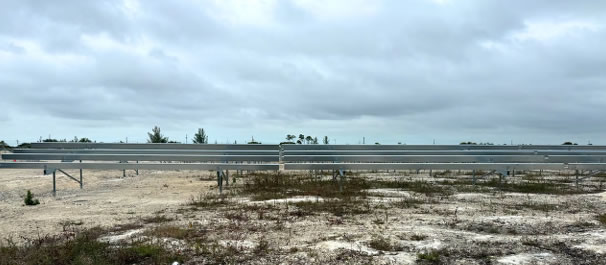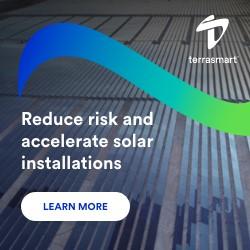Bahamas Solar & Renewables took a non-traditional path to build their first solar site by bypassing the use of an EPC. Instead, they hired local contractors to execute their civil and electrical work. This initiative ensured economic support for the local community.
Case Study from | Terrasmart
Background
Seeking reliable solar performance amid tough island conditions
Freeport Oil Company Limited (FOCOL) was established in 1967 and is a leading supplier of petroleum products and services in The Bahamas & Turks and Caicos. With a mission for “Fueling Growth for People”, FOCOL decided to venture into renewable energy as a natural evolution for the business by creating Bahamas Solar and Renewables (BSR). With a focus on empowering its communities, Bahamas Solar & Renewables took a non-traditional path to build their first solar site by bypassing the use of an EPC. Instead, they hired local contractors to execute their civil and electrical work. This initiative ensured economic support for the local community.
Being in a coastal region, the Freeport, Bahamas solar project faced unique challenges not experienced by most solar sites. While high winds, complex soils, and logistical hurdles impact other regions in the U.S., these obstacles are magnified when developing solar on an island. As Bahamas Solar & Renewables looked to complete their first solar project, they required a reliable solar partner with deep expertise in tackling tough terrain and extreme weather.

Challenges
Overcoming high winds and complex soil on an island
The developer discovered early on that building solar on an island came with high wind loads and subsurface challenges. Without the use of an EPC, Bahamas Solar & Renewables faced the challenge of f inding a racking partner with the right experience that could help ensure success from engineering to installation in the field.
Site Challenges
Tough soils
A standard practice at Terrasmart includes conducting an analysis of the geotechnical report. In this case, it showed challenging soils with 100% refusal. The presence of bedrock, limestone, and silty sand posed a risk that threatened reliability and timelines if not appropriately addressed. With extensive experience working on challenging soils, our seasoned engineers recommended a pull-out test to ensure that the correct foundations were selected.
High wind load
Coastal regions like The Bahamas are no stranger to high wind loads. In 2019, the island was devastated by Hurricane Dorian’s category five winds that reached over 180 mph. With the area’s history of strong storms, regulators required that the solar site withstand wind speeds of up to 180 mph. To address this, Terrasmart performed a tilt angle study to understand module pressures and determine the optimal tilt angle to avoid overstressing the modules, ensuring their durability.
Logistics
Being an island project, shipping logistics had to be carefully managed to ensure all components fit into a 40ft container for the most efficient transport. With a history of delivering to island projects, our experienced team ensured all materials and equipment arrived on time.

Site specifications
Wind load - 180 mph
Soil type - Bedrock, limestone, and silty soils
Estimated refusal - 100%
E/W slope - 12%
N slope - 10%
S slope - 8%
With deep experience building on coastal sites, these challenges were easily mitigated by Terrasmart’s skillful engineering and installation team. With over 50 projects deployed across coastal regions, our experts understand best practices for executing solar in difficult terrain and extreme wind conditions.
Solutions
Racking and foundation expertise that turns any site into success
Since the project had a refusal estimate of 100%, it was clear that ground screws were the best solution to overcome the subsurface challenges; however, our work did not stop there.
To ensure long-lasting reliability and a smooth installation, Terrasmart conducted a pull-out test (also referred to as tension testing) which validates the anchorage of the screw foundations. This involved two tests per location, testing each area for tensile and lateral force. Pull-out tests can be completed for pile or screw foundations and are executed by our in-house team.
Pull-out test process
.jpg)
The outcome of the tensile and lateral tests indicates the site-specific ultimate load for the ground screws. The ultimate load is defined when the ground screw is displaced by more than 1” or when the safe working load of the testing equipment is exceeded.
The data points from the pull-out tests inform the design and engineering for a project. These tests may signal a need for an additional horizontal brace in the racking or that longer screws are needed to meet the project requirements.
For the Freeport project, we selected four pull-out test locations given the challenging mix of soil. Our pull-out tests confirmed that Terrasmart’s 1425 ground screws (56.1” in length) were the optimal choice.
.jpg)
As high wind load risks were a pressing concern for this project, our skilled engineering team thought it essential to complete a tilt angle study. Using coefficients based on the ASCE code, our engineers examined different tilt angles for the specific module used on this project to assess the varying module pressures. They then compared these pressures to the allowable limits, ensuring that the pressure stayed within the acceptable range to prevent overstressing the modules or cracking the glass.
Through this process, we landed on a 13-degree tilt, as the reduced tilt was best for high wind loads.
Additionally, various table sizes were considered, with a smaller 2h x 8w table being selected to ensure the racking could withstand high winds without risk of damage. For the modules, Bahamas Solar & Renewables selected a module designed for high wind areas, as it offered higher allowable uplift loads.
Our solutions for refusal and high wind loads were necessary for this project to continue forward. However, it was our installation services that sealed the deal with Bahamas Solar & Renewables. Our seasoned in-house field team that provides foundation and racking installation was imperative to creating a successful outcome.
Project specifications
Racking - GLIDE Agile
Racking layout - 2h x 8w in portrait
Tilt angle - 100%
Foundation - Terrasmart 1425 Foundation ground screws
Number of screws - 3,936
Number of modules - 15,744
Results
Reliable results in tough conditions
Within a month, Terrasmart was able to complete the installation of racking and foundations for the Freeport project.
Here’s how Terrasmart helped bring Bahamas Solar & Renewables’ mission to life:
Island solar expertise
Our team’s proven experience in building solar solutions across the Caribbean and Hawaii helped guarantee the success of this project. From hurricane-prone zones to remote islands, our solar engineers designed dependable racking and foundations to help communities like Freeport thrive.
Fast installation
Predictable installation starts with good upfront planning. A single partner who understands subsurface and weather challenges, paired with an in-house installation team, ensures seamless execution from beginning to end. When it comes to fast and efficient installation, there is no replacement for experience. Having a team with over a
Built to last
Through a series of rigorous tests, our ground screw-based fixed-tilt racking solution, GLIDE Agile, was proven to easily withstand up to 180-mph winds, providing Bahamas Solar & Renewables with reliable racking that can stand the test of time. Terrasmart’s ground screws overcame challenging soils and the installation by our field team ensured long lasting quality.
Conclusion
On any terrain. In any weather. We’re your partner for progress.
High wind loads, subsurface challenges, and other site-specific conditions can be overwhelming and threaten project timelines. Building solar on challenging terrain and in extreme weather demands expertise and turnkey solutions to mitigate risks and unlock operational efficiency. With 16 years of experience installing solar projects across the U.S., we have a reputation for delivering results that last—even in the toughest conditions.
About Bahamas Solar & Renewables:
Bahamas Solar & Renewables’ passion and values is reflected in the way they work. They empower their customers to produce their own energy, resulting in a positive impact in their local communities. Freeport was a project that was years in the making and challenged by many obstacles. However, they were determined to bring their first solar project to life for the benefit of Grand Bahama.
The content & opinions in this article are the author’s and do not necessarily represent the views of AltEnergyMag

Terrasmart
Terrasmart, the renewable energy portfolio of Gibraltar (NASDAQ: ROCK), is a leading provider of solar racking technologies, electrical balance-of-system products, installation services, and project optimization software. Harnessing the combined strengths, technical expertise, and heritage of its four legacy brands, Terrasmart delivers a holistic project experience providing leading solar technologies and smart solutions across the project lifecycle to mitigate risks and amplify returns for solar projects of any size, type, and location. Serving the commercial, DG and utility sectors across North America, Terrasmart integrates products and solutions across the PV lifecycle to minimize risks and maximize returns. With over 24 GWs of solar deployed across 6,000 PV systems, Terrasmart creates unique value for more profitable solar on any terrain, anywhere in the U.S.
Other Articles
Terrasmart’s Flexible 1P Tracker Speeds Experimental Success
Navigating Slopes for a Competitive Edge
Making a Splash With Solar Energy
More about Terrasmart
Comments (0)
This post does not have any comments. Be the first to leave a comment below.
Featured Product


